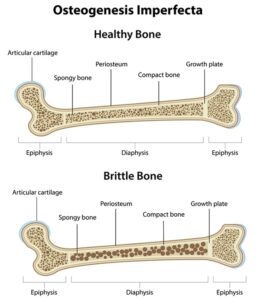At the beginning of week 5, Maddie and I decided that it would be nice to take this week for me to catch up on all of my projects. This included finalizing my patient table, adding more information and research to my Google doc, and some other random things like reading more on the databases. We plan to meet at the beginning of next week to go over my patient table so I can better understand the importance of collecting patient data.
Because I did not do much this week, I thought that I could take this opportunity to tell you all more about myself and why I am interested in genetics. In August of 2017, I was diagnosed with a rare genetic disease called Osteogenesis Imperfecta. Osteogenesis Imperfecta (OI), which roughly translates to imperfect bone formation, is a genetic mutation that causes brittle bones.
There are four main types of OI; type I, II, III, and IV. Type I is the most common and least severe of them. Markers for it include frequent bone fractures during childhood, puberty, and old age. Often people affected have a blue tint to the whites of their eyes. The other three types are much more severe, fractures and malformation of various bones (most often the ribs and long bones) begin at a young age and worsen with time. Each different type of OI is caused by a different mutation. The disease is caused by a mutation in either the COL1A1 gene or the COL1A2 gene (sometimes both). For type I, the mutation more commonly occurs in the COL1A1 gene and causes a reduced amount of collagen to be produced, causing brittle bones. Mutation types I-IV can occur in both COL1A1 and COL1A2 genes and cause a defect in the structure of the collagen produced, which weakens connective tissue (mostly bone).
Before I was diagnosed I had broken about 15 bones from the age of 10 to 15. This was the main reason that my doctor decided to send me to a Pediatric Endocrinologist at Denver Children’s Hospital. After that, I did many tests and was finally diagnosed with type I osteogenesis imperfecta. There is not much they can do since it is a very rare disease and there is not enough research or treatment options. There are some clinical trials for patients affected by OI, but my doctor decided to put me on a Bisphosphonate Pamidronate IV treatment. This is a form of chemotherapy that is often used for elderly people affected by osteoporosis. I receive this treatment every 3 months at the Montrose Memorial Hospital. I have been doing this treatment since 2018. Because of the severity of the drug, my doctors hope to take me off it within the next few years to reduce any damage to my liver. I hope this information can help you understand more about my journey with OI, genetics, and why I am so passionate about this field.


There are no comments published yet.